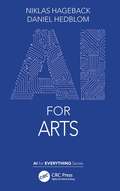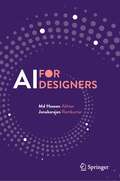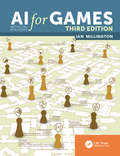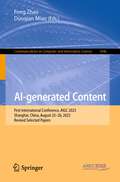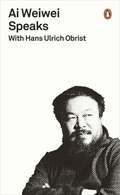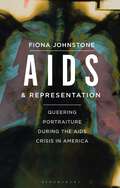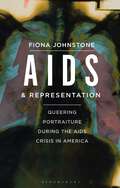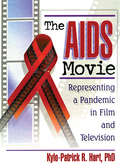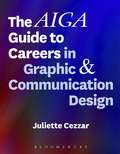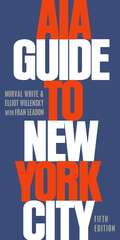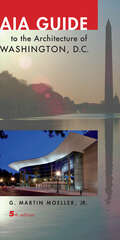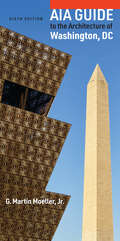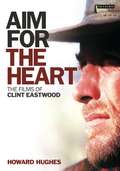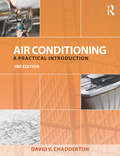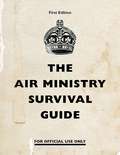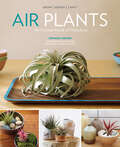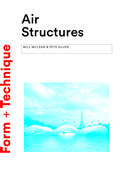- Table View
- List View
AI for Arts (AI for Everything)
by Niklas Hageback Daniel HedblomAI for Arts is a book for anyone fascinated by the man–machine connection, an unstoppable evolution that is intertwining us with technology in an ever-greater degree, and where there is an increasing concern that it will be technology that comes out on top. Thus, presented here through perhaps its most esoteric form, namely art, this unfolding conundrum is brought to its apex. What is left of us humans if artificial intelligence also surpasses us when it comes to art? The articulation of an artificial intelligence art manifesto is long overdue, so hopefully this book can fill a gap that will have repercussions not only for aesthetic and philosophical considerations but possibly more so for the development of artificial intelligence.
AI for Arts (AI for Everything)
by Niklas Hageback Daniel HedblomAI for Arts is a book for anyone fascinated by the man–machine connection, an unstoppable evolution that is intertwining us with technology in an ever-greater degree, and where there is an increasing concern that it will be technology that comes out on top. Thus, presented here through perhaps its most esoteric form, namely art, this unfolding conundrum is brought to its apex. What is left of us humans if artificial intelligence also surpasses us when it comes to art? The articulation of an artificial intelligence art manifesto is long overdue, so hopefully this book can fill a gap that will have repercussions not only for aesthetic and philosophical considerations but possibly more so for the development of artificial intelligence.
AI for Designers
by Md Haseen Akhtar Janakarajan RamkumarThis book presents select research writings from researchers and professionals around the globe on the application, potential, and limitations of AI in different domains. The topics covered include AI in product design, AI in architecture design, AI in textile design, AI in interaction design, and AI for society in general. The book also discusses various cross-applications of AI in other industrial sectors like urban planning and design, AI for inclusive future, etc. The book is a valuable reference for designers in multidisciplinary areas. This book is of interest for anyone who is a beginner, researcher, and professional interested in artificial intelligence and allied fields.
AI for Games, Third Edition
by Ian MillingtonAI is an integral part of every video game. This book helps professionals keep up with the constantly evolving technological advances in the fast growing game industry and equips students with up-to-date information they need to jumpstart their careers. This revised and updated Third Edition includes new techniques, algorithms, data structures and representations needed to create powerful AI in games. Key Features A comprehensive professional tutorial and reference to implement true AI in games Includes new exercises so readers can test their comprehension and understanding of the concepts and practices presented Revised and updated to cover new techniques and advances in AI Walks the reader through the entire game AI development process
AI for Games, Third Edition (Ai For Everything Ser.)
by Ian MillingtonAI is an integral part of every video game. This book helps professionals keep up with the constantly evolving technological advances in the fast growing game industry and equips students with up-to-date information they need to jumpstart their careers. This revised and updated Third Edition includes new techniques, algorithms, data structures and representations needed to create powerful AI in games. Key Features A comprehensive professional tutorial and reference to implement true AI in games Includes new exercises so readers can test their comprehension and understanding of the concepts and practices presented Revised and updated to cover new techniques and advances in AI Walks the reader through the entire game AI development process
AI-generated Content: First International Conference, AIGC 2023, Shanghai, China, August 25–26, 2023, Revised Selected Papers (Communications in Computer and Information Science #1946)
by Feng Zhao Duoqian MiaoThis book constitutes the revised selected papers of the First International Conference, AIGC 2023, held in Shanghai, China, during August 25–26, 2023The 30 full papers included in this volume were carefully reviewed and selected from 62 submissions. The volume focuses on the remarkable strides that have been made in the realm of artificial intelligence and its transformative impact on content creation. As delving into the content of the proceedings, the readers will encounter cutting-edge research findings, innovative applications, and thought-provoking insights that underscore the transformative potential of AI-generated content.
AI in Museums: Reflections, Perspectives and Applications (Edition Museum #74)
by Sonja Thiel Johannes C. BernhardtArtificial intelligence is becoming an increasingly important topic in the cultural sector. While museums have long focused on building digital object databases, the existing data can now become a field of application for machine learning, deep learning and foundation model approaches. This goes hand in hand with new artistic practices, curation tools, visitor analytics, chatbots, automatic translations and tailor-made text generation. With a decidedly interdisciplinary approach, the volume brings together a wide range of critical reflections, practical perspectives and concrete applications of artificial intelligence in museums, and provides an overview of the current state of the debate.
Ai Weiwei Speaks: with Hans Ulrich Obrist (A\penguin Special Ser.)
by Hans Ulrich Obrist'If artists betray the social conscience and the basic principles of being human, where does art stand then?' Ai Weiwei - artist, architect, curator, publisher, poet and urbanist - extended the notion of art and is one of the world's most significant creative and cultural figures. In this series of interviews, conducted over several years with the curator Hans Ulrich Obrist, he discusses the many dimensions of his artistic life, ranging over subjects including ceramics, blogging, nature, philosophy and the myriad influences that have fed into his work. He also talks candidly about his father, his childhood spent in exile and his criticism of the Chinese state. Together, these extraordinary discussions give a unique insight into the outstanding complexity of Ai Weiwei's thought and work, and are an essential reminder of the need for personal, political and artistic freedom.
AIDS and Representation: Queering Portraiture during the AIDS Crisis in America
by Fiona JohnstoneAIDS & Representation explores portraits and self-portraits made in response to the AIDS epidemic in America in the 1980s and 1990s. Addressing the work of artists including Mark Morrisroe, Robert Blanchon and Felix Gonzalez-Torres through the interrelated themes of sickness and mortality, desire and sexual identity, love and loss, Fiona Johnstone shows how the self-representational practices of artists with HIV and AIDS offered a richly imaginative response to the limitations of early AIDS imagery. Johnstone argues that the AIDS epidemic changed the very nature of visual representation and artistic practice, necessitating a radical new approach to conceptualising and visualising the human form. An extended epilogue considers the ongoing art historicization of the epidemic, re-contextualising the book's themes in relation to contemporary photographic works.More than just a historical discussion of the art of the AIDS crisis, AIDS and Representation contributes to an emergent body of scholarship on the visual representation of illness. Expanding the established genre of the autopathography or illness narrative beyond the predominantly textual, this important contribution to art history and health humanities sensitively unpicks the entanglements between aesthetic form and the expression of lived experiences of critical and chronic ill health.
AIDS and Representation: Queering Portraiture during the AIDS Crisis in America
by Fiona JohnstoneAIDS & Representation explores portraits and self-portraits made in response to the AIDS epidemic in America in the 1980s and 1990s. Addressing the work of artists including Mark Morrisroe, Robert Blanchon and Felix Gonzalez-Torres through the interrelated themes of sickness and mortality, desire and sexual identity, love and loss, Fiona Johnstone shows how the self-representational practices of artists with HIV and AIDS offered a richly imaginative response to the limitations of early AIDS imagery. Johnstone argues that the AIDS epidemic changed the very nature of visual representation and artistic practice, necessitating a radical new approach to conceptualising and visualising the human form. An extended epilogue considers the ongoing art historicization of the epidemic, re-contextualising the book's themes in relation to contemporary photographic works.More than just a historical discussion of the art of the AIDS crisis, AIDS and Representation contributes to an emergent body of scholarship on the visual representation of illness. Expanding the established genre of the autopathography or illness narrative beyond the predominantly textual, this important contribution to art history and health humanities sensitively unpicks the entanglements between aesthetic form and the expression of lived experiences of critical and chronic ill health.
The AIDS Movie: Representing a Pandemic in Film and Television
by Kylo-Patrick R HartAre people with HIV/AIDS treated fairly in films?Here is a compelling book that provides you with a thorough examination of how HIV/AIDS is characterized and portrayed in film and how this portrayal affects American culture. The AIDS Movie: Representing a Pandemic in Film and Television uncovers the primary ways that films about HIV/AIDS influence American ideology and contribute to society's view of the disease. In The AIDS Movie, professors and scholars in the areas of popular culture, film, sociology, and gay and lesbian studies will discover cross-cultural approaches that can be used to analyze the representation of AIDS in American films made in the first two decades of the pandemic. Giving you insight into the production and circulation of social meanings pertaining to HIV/AIDS, this study explores the social ramifications of such representations for gay men in American society, as well as for the rest of the population. Interesting and informative, The AIDS Movie: Representing a Pandemic in Film and Television examines the ways that AIDS has been represented in American movies over the past two decades, defines and proposes criteria for identifying an “AIDS movie” and explores how these images shape social opinions about AIDS and gay men. The AIDS Movie discusses several character types such as “innocent victims” and “guilty villains” and the process of victim-blaming that occurs in AIDS movies. Defining an “AIDS movie” as a film with at least one character who either has been infected with HIV, has developed AIDS, or is grieving the recent death of a loved one from AIDS, this guide bases standards for these movies on several works, including: Chocolate Babies It's My Party Jeffrey The Living End Grief An Early Frost Men in Love A Place for Annie Philadelphia The Ryan White Story Gia Boys on the SideThe AIDS Movie: Representing a Pandemic in Film and Television is compelling and insightful as it cleverly reveals how AIDS is portrayed in cinema and television, and how that portrayal affects American culture.
The AIDS Movie: Representing a Pandemic in Film and Television
by Kylo-Patrick R HartAre people with HIV/AIDS treated fairly in films?Here is a compelling book that provides you with a thorough examination of how HIV/AIDS is characterized and portrayed in film and how this portrayal affects American culture. The AIDS Movie: Representing a Pandemic in Film and Television uncovers the primary ways that films about HIV/AIDS influence American ideology and contribute to society's view of the disease. In The AIDS Movie, professors and scholars in the areas of popular culture, film, sociology, and gay and lesbian studies will discover cross-cultural approaches that can be used to analyze the representation of AIDS in American films made in the first two decades of the pandemic. Giving you insight into the production and circulation of social meanings pertaining to HIV/AIDS, this study explores the social ramifications of such representations for gay men in American society, as well as for the rest of the population. Interesting and informative, The AIDS Movie: Representing a Pandemic in Film and Television examines the ways that AIDS has been represented in American movies over the past two decades, defines and proposes criteria for identifying an “AIDS movie” and explores how these images shape social opinions about AIDS and gay men. The AIDS Movie discusses several character types such as “innocent victims” and “guilty villains” and the process of victim-blaming that occurs in AIDS movies. Defining an “AIDS movie” as a film with at least one character who either has been infected with HIV, has developed AIDS, or is grieving the recent death of a loved one from AIDS, this guide bases standards for these movies on several works, including: Chocolate Babies It's My Party Jeffrey The Living End Grief An Early Frost Men in Love A Place for Annie Philadelphia The Ryan White Story Gia Boys on the SideThe AIDS Movie: Representing a Pandemic in Film and Television is compelling and insightful as it cleverly reveals how AIDS is portrayed in cinema and television, and how that portrayal affects American culture.
The AIGA Guide to Careers in Graphic and Communication Design
by Juliette CezzarWhat graphic design is, what designers need to know, and who becomes a designer have all evolved as the computer went from being a tool to also becoming our primary medium for communication. How jobs are advertised and how prospective candidates communicate with prospective employers have changed as well, as has the culture and context for many workplaces, requiring new approaches for how to find your first (and last) position. Through clear prose, a broad survey of contexts where designers find themselves in the present day, and interviews with designers, The AIGA Guide to Careers in Graphic and Communication Design is an invaluable resource for finding your place in this quickly changing and growing field. The book includes interviews with over 40 designers at all levels working in-house and out-of-house in studios, consultancies, or alone, including: Nicholas Blechman, The New Yorker; Rob Giampietro, Google; Njoki Gitahi, IDEO; Hilary Greenbaum, Whitney Museum; Holly Gressley, Vox Media; Cemre Güngör, Facebook; Natasha Jen, Pentagram; Renda Morton, The New York Times; and Alisa Wolfson, Leo Burnett Worldwide.
The AIGA Guide to Careers in Graphic and Communication Design
by Juliette CezzarWhat graphic design is, what designers need to know, and who becomes a designer have all evolved as the computer went from being a tool to also becoming our primary medium for communication. How jobs are advertised and how prospective candidates communicate with prospective employers have changed as well, as has the culture and context for many workplaces, requiring new approaches for how to find your first (and last) position. Through clear prose, a broad survey of contexts where designers find themselves in the present day, and interviews with designers, The AIGA Guide to Careers in Graphic and Communication Design is an invaluable resource for finding your place in this quickly changing and growing field. The book includes interviews with over 40 designers at all levels working in-house and out-of-house in studios, consultancies, or alone, including: Nicholas Blechman, The New Yorker; Rob Giampietro, Google; Njoki Gitahi, IDEO; Hilary Greenbaum, Whitney Museum; Holly Gressley, Vox Media; Cemre Güngör, Facebook; Natasha Jen, Pentagram; Renda Morton, The New York Times; and Alisa Wolfson, Leo Burnett Worldwide.
AIA Guide to New York City
by Fran Leadon Norval White Elliot WillenskyHailed as "extraordinarily learned" (New York Times), "blithe in spirit and unerring in vision," (New York Magazine), and the "definitive record of New York's architectural heritage" (Municipal Art Society), Norval White and Elliot Willensky's book is an essential reference for everyone with an interest in architecture and those who simply want to know more about New York City. First published in 1968, the AIA Guide to New York City has long been the definitive guide to the city's architecture. Moving through all five boroughs, neighborhood by neighborhood, it offers the most complete overview of New York's significant places, past and present. The Fifth Edition continues to include places of historical importance--including extensive coverage of the World Trade Center site--while also taking full account of the construction boom of the past 10 years, a boom that has given rise to an unprecedented number of new buildings by such architects as Frank Gehry, Norman Foster, and Renzo Piano. All of the buildings included in the Fourth Edition have been revisited and re-photographed and much of the commentary has been re-written, and coverage of the outer boroughs--particularly Brooklyn--has been expanded. Famed skyscrapers and historic landmarks are detailed, but so, too, are firehouses, parks, churches, parking garages, monuments, and bridges. Boasting more than 3000 new photographs, 100 enhanced maps, and thousands of short and spirited entries, the guide is arranged geographically by borough, with each borough divided into sectors and then into neighborhood. Extensive commentaries describe the character of the divisions. Knowledgeable, playful, and beautifully illustrated, here is the ultimate guided tour of New York's architectural treasures. Acclaim for earlier editions of the AIA Guide to New York City: "An extraordinarily learned, personable exegesis of our metropolis. No other American or, for that matter, world city can boast so definitive a one-volume guide to its built environment." -- Philip Lopate, New York Times "Blithe in spirit and unerring in vision." -- New York Magazine "A definitive record of New York's architectural heritage... witty and helpful pocketful which serves as arbiter of architects, Baedeker for boulevardiers, catalog for the curious, primer for preservationists, and sourcebook to students. For all who seek to know of New York, it is here. No home should be without a copy." -- Municipal Art Society "There are two reasons the guide has entered the pantheon of New York books. One is its encyclopedic nature, and the other is its inimitable style--'smart, vivid, funny and opinionated' as the architectural historian Christopher Gray once summed it up in pithy W & W fashion." -- Constance Rosenblum, New York Times "A book for architectural gourmands and gastronomic gourmets." -- The Village Voice
AIA Guide to New York City
by Norval White Elliot Willensky Fran LeadonHailed as "extraordinarily learned" (New York Times), "blithe in spirit and unerring in vision," (New York Magazine), and the "definitive record of New York's architectural heritage" (Municipal Art Society), Norval White and Elliot Willensky's book is an essential reference for everyone with an interest in architecture and those who simply want to know more about New York City. First published in 1968, the AIA Guide to New York City has long been the definitive guide to the city's architecture. Moving through all five boroughs, neighborhood by neighborhood, it offers the most complete overview of New York's significant places, past and present. The Fifth Edition continues to include places of historical importance--including extensive coverage of the World Trade Center site--while also taking full account of the construction boom of the past 10 years, a boom that has given rise to an unprecedented number of new buildings by such architects as Frank Gehry, Norman Foster, and Renzo Piano. All of the buildings included in the Fourth Edition have been revisited and re-photographed and much of the commentary has been re-written, and coverage of the outer boroughs--particularly Brooklyn--has been expanded. Famed skyscrapers and historic landmarks are detailed, but so, too, are firehouses, parks, churches, parking garages, monuments, and bridges. Boasting more than 3000 new photographs, 100 enhanced maps, and thousands of short and spirited entries, the guide is arranged geographically by borough, with each borough divided into sectors and then into neighborhood. Extensive commentaries describe the character of the divisions. Knowledgeable, playful, and beautifully illustrated, here is the ultimate guided tour of New York's architectural treasures. Acclaim for earlier editions of the AIA Guide to New York City: "An extraordinarily learned, personable exegesis of our metropolis. No other American or, for that matter, world city can boast so definitive a one-volume guide to its built environment." -- Philip Lopate, New York Times "Blithe in spirit and unerring in vision." -- New York Magazine "A definitive record of New York's architectural heritage... witty and helpful pocketful which serves as arbiter of architects, Baedeker for boulevardiers, catalog for the curious, primer for preservationists, and sourcebook to students. For all who seek to know of New York, it is here. No home should be without a copy." -- Municipal Art Society "There are two reasons the guide has entered the pantheon of New York books. One is its encyclopedic nature, and the other is its inimitable style--'smart, vivid, funny and opinionated' as the architectural historian Christopher Gray once summed it up in pithy W & W fashion." -- Constance Rosenblum, New York Times "A book for architectural gourmands and gastronomic gourmets." -- The Village Voice
AIA Guide to the Architecture of Washington, D.C.
by G. Martin Moeller Jr.This lively and informative guide offers tourists, residents, and architecture aficionados alike insights into more than 400 of Washington, D.C.’s, most important landmarks. Organized into 19 discrete tours, this thoroughly redesigned and updated edition includes 45 new entries, encompassing the House of Sweden and the U.S. Institute of Peace, classic buildings that epitomize the city—the White House, the Capitol, Union Station—and a number of private buildings off the beaten path.G. Martin Moeller, Jr., blends informed, concise descriptions with engaging commentary on each landmark, revealing often-surprising details of the buildings' history and design. Every entry is accompanied by a photograph and includes the structure's location, its architects and designers, and the corresponding dates of completion. Each entry is keyed to an easy-to-read map at the beginning of the tour.From the imposing monuments of Capitol Hill and the Mall to the pastoral suburban enclaves of Foxhall and Cleveland Park, from small memorials to vast commercial and institutional complexes, this guide shows us a Washington that is at once excitingly fresh and comfortably familiar.
AIA Guide to the Architecture of Washington, DC
by G. Martin Moeller Jr."The model of what a concise, attractive guidebook should be."—Mid-Atlantic CountryThis lively and informative guide offers tourists, residents, and architecture aficionados insights into nearly 450 of Washington, DC's, most noteworthy buildings and monuments. Organized into 19 discrete walking tours, plus one general tour of peripheral sites, this thoroughly revised sixth edition features projects ranging from early federal landmarks to twenty-first-century commercial, institutional, and residential buildings. It includes some 80 new entries covering dozens of recently completed buildings, along with some historic structures that may have been overlooked in the past. The guide also has updated maps, and many existing entries have been rewritten to reflect recent renovations, changes to the buildings' contexts, or additional scholarship.G. Martin Moeller, Jr., blends informed, concise descriptions with engaging commentary on each landmark, revealing surprising details of the buildings' history and design. Every entry is accompanied by a photograph and includes the structure's location, its architects and designers, and the corresponding dates of completion. Each entry is keyed to an easy-to-read map at the beginning of the tour.From the imposing monuments of Capitol Hill and the Mall to the pastoral suburban enclaves of Foxhall and Cleveland Park, from small memorials to vast commercial and institutional complexes, this guide shows us a Washington that is at once excitingly fresh and comfortably familiar. The additions and revisions incorporated into the latest edition illuminate broader demographic and physical changes in the city, including the emergence of new neighborhoods and the redevelopment of once-neglected areas.
AIA Guide to the Architecture of Washington, DC
by G. Martin Moeller Jr."The model of what a concise, attractive guidebook should be."—Mid-Atlantic CountryThis lively and informative guide offers tourists, residents, and architecture aficionados insights into nearly 450 of Washington, DC's, most noteworthy buildings and monuments. Organized into 19 discrete walking tours, plus one general tour of peripheral sites, this thoroughly revised sixth edition features projects ranging from early federal landmarks to twenty-first-century commercial, institutional, and residential buildings. It includes some 80 new entries covering dozens of recently completed buildings, along with some historic structures that may have been overlooked in the past. The guide also has updated maps, and many existing entries have been rewritten to reflect recent renovations, changes to the buildings' contexts, or additional scholarship.G. Martin Moeller, Jr., blends informed, concise descriptions with engaging commentary on each landmark, revealing surprising details of the buildings' history and design. Every entry is accompanied by a photograph and includes the structure's location, its architects and designers, and the corresponding dates of completion. Each entry is keyed to an easy-to-read map at the beginning of the tour.From the imposing monuments of Capitol Hill and the Mall to the pastoral suburban enclaves of Foxhall and Cleveland Park, from small memorials to vast commercial and institutional complexes, this guide shows us a Washington that is at once excitingly fresh and comfortably familiar. The additions and revisions incorporated into the latest edition illuminate broader demographic and physical changes in the city, including the emergence of new neighborhoods and the redevelopment of once-neglected areas.
Aim for the Heart: The Films of Clint Eastwood
by Howard HughesClint Eastwood is one of the world's most popular action stars,who has matured into a fine American producer-director. Entertaining, illuminating and packed with information, up to and including The Changeling, this is the first book to cover his full life in the movies, from his beginnings in 1950s B-movies and in TV's Rawhide to Gran Torino showing how as both actor and filmmaker Eastwood aims for the heart of the drama, whatever the story.Howard Hughes follows Eastwood's craft through over 50 movies. He looks at his launch into superstardom in Sergio Leone's 1960s spaghetti westerns. Back in America, he built on his success as western hero with such films as High Plains Drifter and The Outlaw Josey Wales, winning an Oscar for Unforgiven in 1992. He blasted his way through the seventies and eighties as Inspector Harry Francis Callahan, the last hope for law enforcement in San Francisco. He also monkeyed around in two phenomenally popular films with Clyde the orang-utan, which brought tough-guy Eastwood to a whole new audience and made him the biggest box office star of his generation.Aim for the Heart also looks at Eastwood's more unusual roles, including The Beguiled, The Bridges of Madison County and Million Dollar Baby. Since 1970, he has enjoyed parallel success as directorproducer of his own Malpaso Productions, with Bird, Mystic River and Letters from Iwo Jima, demonstrating formidable directing credentials.Aim for the Heart covers all Eastwood's movies of many genres in detail, and Eastwood's story is illustrated with film stills, glimpses behind the scenes, and rare poster advertising material. Aim for the Heart also includes the most comprehensive credits filmography has ever compiled on Eastwood's work, as star and director.
Air Conditioning: A Practical Introduction
by David V. ChaddertonDavid Chadderton's Air Conditioning is the complete introduction and reference guide for students and practitioners of air conditioning design, installation and maintenance. The scientific principles involved are introduced with the help of case studies and exercises, and downloadable spreadsheets help you work through important calculations. New chapters on peak summertime air temperature in buildings without cooling systems, air duct acoustic calculations and air conditioning system cost enhance the usefulness to design engineers. Case studies are created from real life data, including PROBE post-occupancy reports, relating all of the theoretical explanations to current practice. Trends and recent applications in lowering energy use by air conditioning are also addressed, keeping the reader informed of the latest sustainable air conditioning technologies. Over 75 multiple choice questions will help the reader check on their progress. Covering both tropical and temperate climates, this is the ideal book for those learning about the basic principles of air conditioning, seeking to understand the latest technological developments, or maintaining a successful HVAC practice anywhere in the world.
Air Conditioning: A Practical Introduction
by David V. ChaddertonDavid Chadderton's Air Conditioning is the complete introduction and reference guide for students and practitioners of air conditioning design, installation and maintenance. The scientific principles involved are introduced with the help of case studies and exercises, and downloadable spreadsheets help you work through important calculations. New chapters on peak summertime air temperature in buildings without cooling systems, air duct acoustic calculations and air conditioning system cost enhance the usefulness to design engineers. Case studies are created from real life data, including PROBE post-occupancy reports, relating all of the theoretical explanations to current practice. Trends and recent applications in lowering energy use by air conditioning are also addressed, keeping the reader informed of the latest sustainable air conditioning technologies. Over 75 multiple choice questions will help the reader check on their progress. Covering both tropical and temperate climates, this is the ideal book for those learning about the basic principles of air conditioning, seeking to understand the latest technological developments, or maintaining a successful HVAC practice anywhere in the world.
The Air Ministry Survival Guide (Air Ministry Survival Guide)
by NoneTHE ULTIMATE SURVIVAL GUIDE for anyone who thinks they'd survive the world's most hostile environments - or at least imagine they could do.THE ULTIMATE SURVIVAL GUIDE for anyone who thinks they'd survive the world's most hostile environments - or at least imagine they could do.-----------------------------First issued to British airmen in the 1950s the beautifully illustrated Air Ministry Survival Guide provides invaluable practical tips and instruction on how to keep calm and carry on in any hostile environment.Whether you're lost in the desert, arctic, jungle, or adrift on the open ocean, you'll be better off armed with sensible advice on how to:- Build a structurally sound igloo- Pull faces to prevent frostbite (and when to expect bits to fall off should you fail)- Fashion a mask to prevent snowblindness- Make a hat out of seat cushions- Behave in the event of meeting hostile locals- Stay safe from poisonous reptiles and insects- Use a 'fire thong'- Punch man-eating sharks (which are cowards)
Air Plants: The Curious World of Tillandsias
by Zenaida SengoKnown for their spiky shape and extremely low-maintenance needs, air plants are growing increasingly popular for crafting, design, and décor. Because they don&’t need soil, you can learn the best tips and tricks in Air Plants to dangle and perch tullandsias almost anywhere in your home.
Air Structures (Form + Technique)
by Pete Silver Peter Silver William McLeanAir can be used in a variety of ways to make lightweight, flexible structures. It can be used to make inflatable structures, mobile structures, and temporary buildings, it can also activate movable elements and act as a means of constructing buildings that would be impossible with conventional construction methods.This book looks at every facet of the subject, examining the different types of air structure: super pressure buildings, air beam structures, buoyant structures, inflatable structures, and many more. It also looks at the construction methods that use air, such as air-inflated steel, aerated concrete and blow moulding. Filled with photographs, models, drawings, and diagrams, this is the ideal book for curious students, designers and architects.
